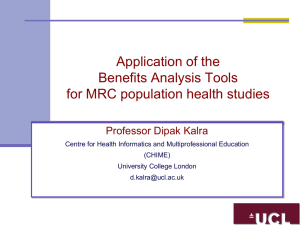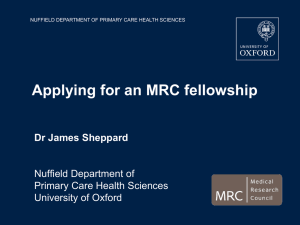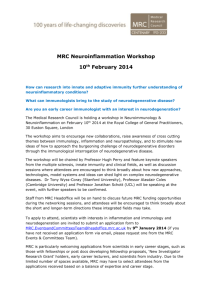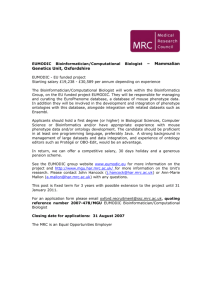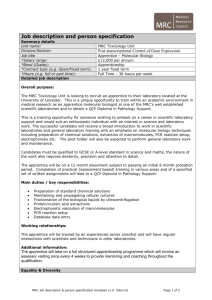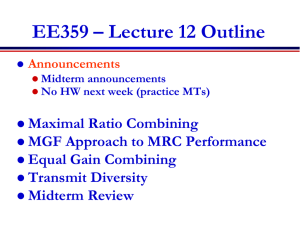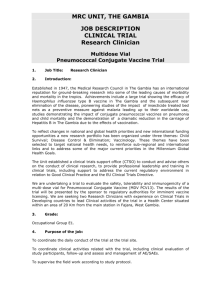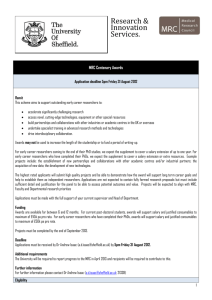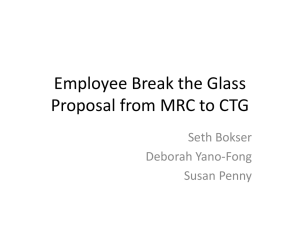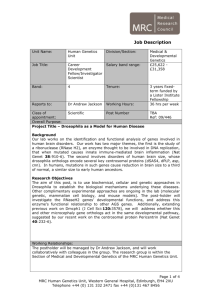Jill Jones` presentation
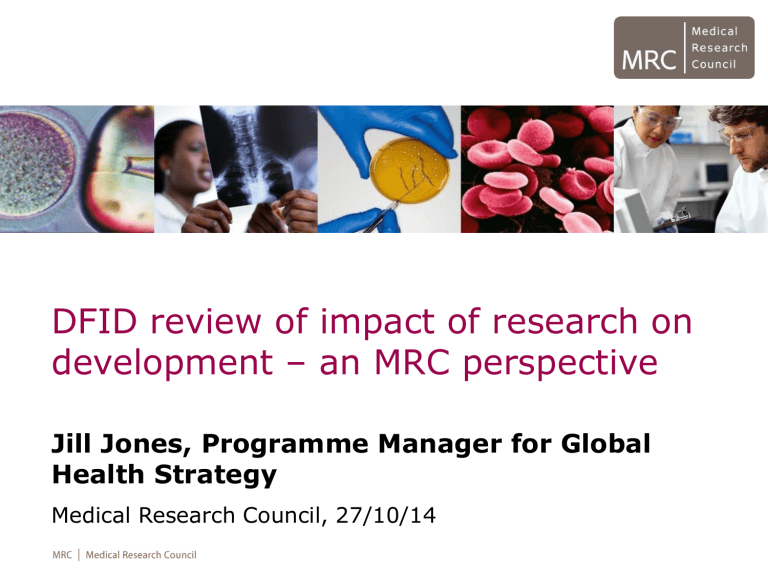
DFID review of impact of research on development – an MRC perspective
Jill Jones, Programme Manager for Global
Health Strategy
Medical Research Council, 27/10/14
MRC discoveries and developments
• Rickets caused by lack of vitamin D (1916)
• Discovery and development of penicillin (1940s)
• Pioneered randomised controlled trial design (1940s)
• Discovery of link between smoking and cancer (1950s)
• Clinical trials for radiotherapy for cancer (1960s)
• Clinical trials of chemotherapy for leukaemia (1970s)
• Invention of DNA fingerprinting (1980s)
• Gene for Huntington’s disease discovered (1990s)
• Humanised therapeutic antibodies in widespread use (2000s)
Comments on DFID literature review:
Economic Growth
• research in low resource settings unlikely to lead to economic growth
• due to absence of commercialisation opportunities/capacity
Research alone cannot drive development
Research community
UK Government
Departments
OSCHR Innovate UK
UK Clinical Research
Collaboration
Public
Learned societies
MRC
MRCT
Parliamentarians
Policy-makers
Universities NIHR
Industry
Research
Councils
International
Medical charities Patients and carers
NHS
MRC translational activities
Translational
Research
Support
Developmental Pathway
Funding Scheme
TSB
Developmental
Clinical Studies
Translational Stem Cell Research Programme
Basic research
Prototype discovery and design
Pre-clinical development
Early clinical trials
Continued commitment to basic lab, clinical and population research
Targeted initiatives to alleviate bottlenecks
Infrastructure/Resources
Methodology
Training
NIHR
Late clinical trials
Capacity building
Economic benefits of
MRC research
• The development of more than 900 products and interventions between 2006 and 2013.
• Creation or growth of 109 companies.
• 667 patents granted or published between 2006 and 2013, with around 34 per cent licensed.
• 30 per cent of the MRC’s further funding comes from outside of the UK – this equates to £958m since 2006. 6 per cent of the MRC’s further funding comes from the private sector – equalling £197m.
• MRC researchers have reported embarking on almost 14,000 unique collaborations since 2006 – 7 per cent of these are with industry partners.
MRC Strategic Plan 2014-2019
Research Changes Lives 2014-2019
Strategic intent: to support excellent discovery science and partnerships to promote translation to accelerate the pace of improvements in health and wealth.
• Strategic Aim One: Picking research that delivers
Setting research priorities which are most likely to deliver improved health outcomes
• Strategic Aim Two: Research to people
Bringing the benefits of excellent research to all sections of society
• Strategic Aim Three: Going global
Accelerating progress in international health research
• Strategic Aim Four: Supporting scientists
Sustaining a robust and flourishing environment for world-class research
DFID literature review: Human capital
• P48 ‘research suggests that investment in doing research in low-income countries on its own will not lead to improved research capacity and that an effective and explicit capacity
building strategy must be developed’
• MRC developing its research capacity building strategy.
• P22 it is important that local actors have ownership of capacity building programmes.
DFID literature review: Pro-poor interventions, policy and practice
• P48 &50 There is evidence that some products and technologies have direct positive socioeconomic impacts
• Development of pro-poor interventions – importance of user input and testing
• There is strong evidence that using research evidence to inform policy and practice leads to benefits which contribute to socioeconomic development.
• P49 ‘Major barriers to use of evidence are the low capacity of policy makers and practitioners to understand and use research evidence, and the absence of incentives to drive research usage. Interventions which succeed in increasing use of evidence by policy-makers and practitioners may lead to important impacts.’
Research for development - conclusions
• Research alone cannot drive development
• Research can drive development when there is a translation system in place (e.g. links to health policy, health system, industry). More relevant to middle income settings.
• Research can accelerate progression on the drivers of development in all settings e.g. health
– Links to policy-maker demand and user-needs are essential for impact
Newton fund
• Newton Fund not looking at countries with low levels of research capacity - it is aimed at countries that have emerging research capacities. Therefore there is more likely to be the ‘research-impact’ system emerging or in place.
• What is new about Newton is not the concept of conducting research with LMICs – we already do this.
• What is new about Newton, is the emphasis on the benefits of engaging at the research funder and governmental research policy level. We were doing this, but Newton has formalised, promoted and increased this.
Impact on Future MRC global health strategy
• Links with overseas funders are key. They are the link into their ‘research-impact’ system just like MRC links in the UK
‘health research-health impact’ system.
• Where no such funder-funder links are possible, continue to encourage researchers to foster user, policy + practitioner level links
– e.g. DFID/ESRC/MRC/WT Health systems research scheme.
– Questions under ‘pro poor technologies’ and ‘evidenceinformed policy/practice’ really helpful in redirecting emphasis for some of our calls for proposals.
• Strategy development for capacity building programmes
